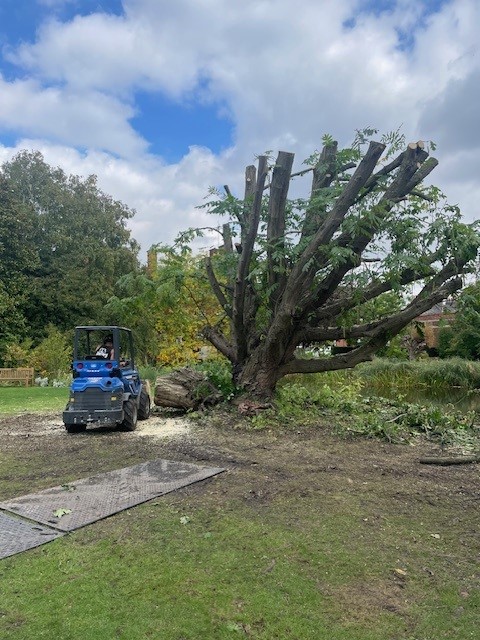Blog
1 October 2024
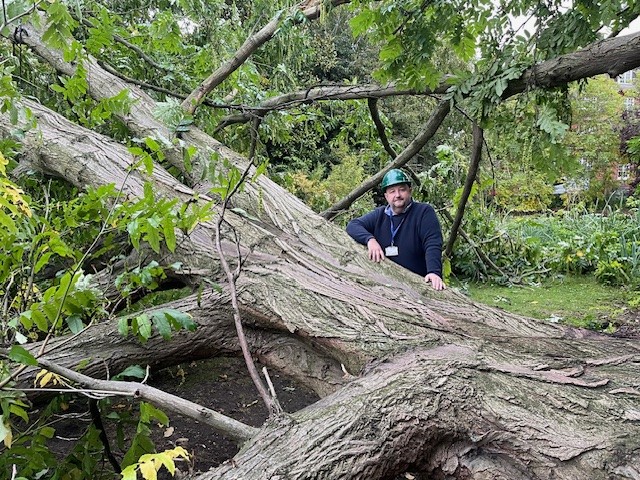
The last few weeks have been a bit tricky in the college gardens. The late summer sunshine did not get the memo, and the team have been hampered by some unseasonal wet spells and high winds. This weather couldn’t have made itself more apparent than a couple of weeks ago, when we noticed something strange about our beloved pterocarya tree (Caucasian Wingnut) in the Jester Garden by the pond.
We had noticed that, the last time we mowed the grass under the tree, the branches seemed a little lower to the ground than what we had noticed before. At that stage, the difference was very subtle, and we put that down to the exceptional year of growth that we have experienced in all areas of the gardens.
On the Monday morning, we noticed that the branches were lower still. On closer inspection, we noticed a crack in the bottom of the trunk. We decided to call out the tree surgeons for a closer inspection. As a precaution, we barriered this area off just in case. The tree was diagnosed with something called bark inclusion and that was the reason the branches were slightly lower than before. We agreed a plan to take some weight from the lower branches.
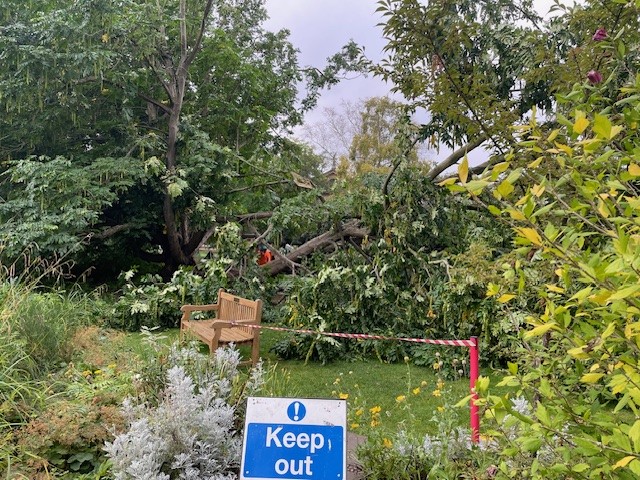
As it happened, it was wise to barrier that area off. At around 8pm, the tree literally fell in half and into the Jester Garden. On closer inspection on Tuesday morning as I returned to work, the damage was clearer to see. The area that was split at the base of the tree had completely fallen apart and caused a basal failure.
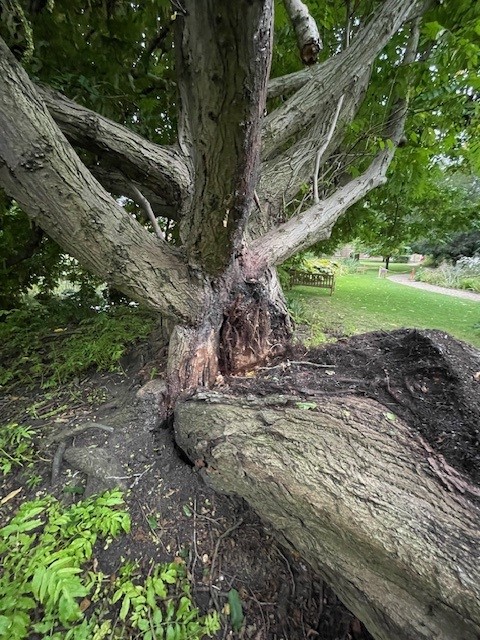
Bark inclusion occurs mainly on a multi-stem tree. It happens when two lower branches grow together and almost grow into each other. As the branches forge together the bark continues to grow and the bark becomes included. Over time, this produces enormous force upon the tree, literally pulling itself apart as it grows. Trees with included bark are, on average, 25% weaker than those with one solid union. The pterocarya tree in the Jester Garden had included bark at the base, but this was not obvious and looked just like a gnarly tree trunk. The tree survey that was carried out less that two years ago showed that the tree was still in good health. The survey did note a small area of mycelium growing around the base of the trunk, but this did not seem to be in danger.
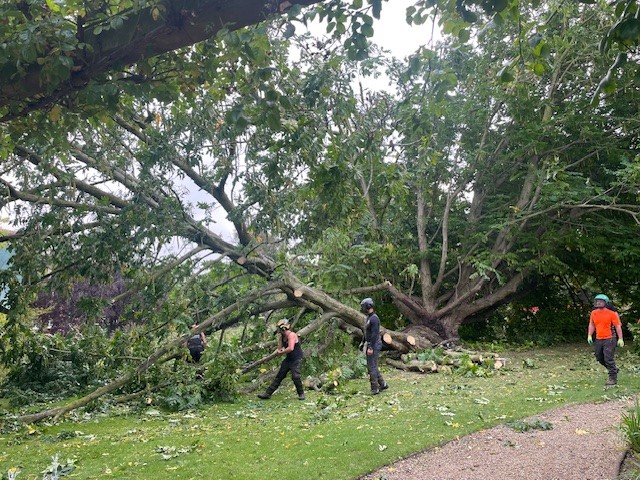
The tree fell because of two things. The first was that it was under a large amount of force due to the bark inclusion and, secondly, that the tree's brace had failed and snapped. At some point, the tree had been pulled back in line with the aid of a tree brace placed high up into the tree. This problem had obviously been an issue in the past. However, there were no tree records nor survey records when I took over as Head Gardener. The tree braces are supposed to be checked every five years. The braces were placed so high in the tree that they were not visible on a ground inspection. Even the tree surveyors did not pick up the tree braces in the tree. There was so much force on the tree braces with the force of the tree growing apart that they eventually failed. The weight of the branches in the tree and the force growing apart pulled the tree apart, almost like somebody pulling on a wishbone of a chicken. The tree could not take the force.
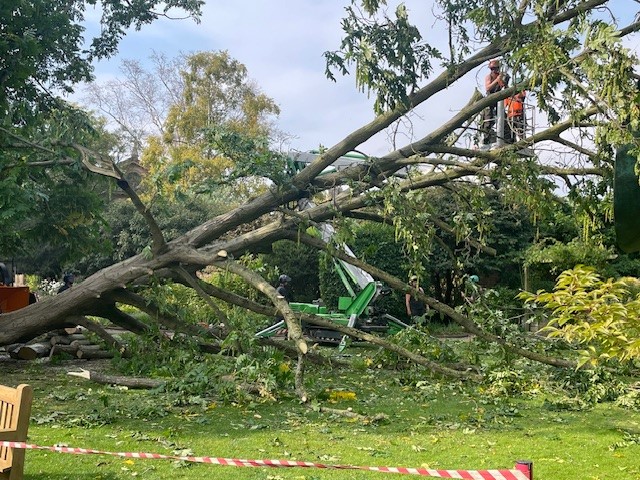
I took professional advice from several tree consultants and tree surgeons about the best way to tackle the problem. The initial thought was that we could reduce some of the weight and tree and winch the tree back together and strap it. The break was in a position that theoretically meant this may have been possible. However, it soon became evident that this approach would not be possible. There was simply too much weight in the tree and, as the tree surgeons started work, the tree shifted once more, revealing even more damage. Collectively, we had to make hard decisions and, although this is a prominent and important tree within the Emmanuel gardens, safety had to be our primary concern. It was agreed that, in the first instance, we would try and save the tree at all costs.
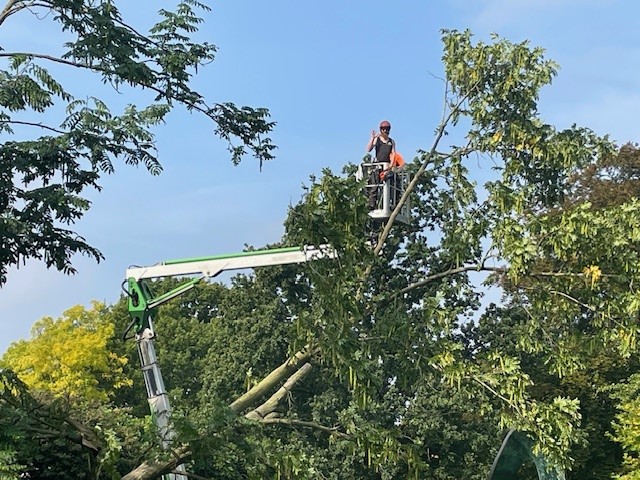
There was significant basal failure and multiple breaks in the lower trunk. We had to remove approximately 80% of the tree at a time of year when it was not ideal. Time will tell how the tree will recover, if at all. The tree will likely send up multiple shoots from the ground as a response. This tree does that naturally anyway, but we expect the tree will send up many more shoots as a survival response. This shooting is called epicormic growth (water shoots). Usually, our management techniques would see us remove these shoots. However, we will leave the shoots for now as they will capture essential sugars in the leaves that will aid the tree’s recovery.
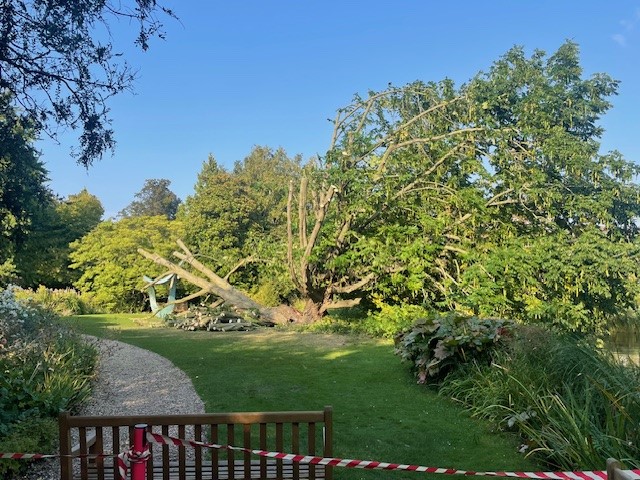
This tree will not look as before for many years, but we will try and keep it. The tree will hold many memories for all that have stood under it in the shade. I think I have a responsibility to try and fight for the tree. The immediate look of the landscape will change and there is nobody more upset about this than myself. I do have to remind myself that I work alongside nature every day, that these are living, breathing specimens. Veteran trees become part of our lives forever, but now and again they fail. Climate change will have played a huge part in the life of the tree. Everywhere is seeing premature tree deaths and problems with branch necrosis. At Emmanuel College, we are not alone in these factors. Tree stress will usually not manifest until several years after extreme weather events. The hottest summers, the driest spells, the wettest springs, the record wind strengths and the multiple number of storms will inevitably take their toll. The average life span of veteran trees has been shortened. Tree failure will become more commonplace. I have not given up on our pterocarya tree yet, though - although failure may be its inevitable fate.
Best wishes.
Brendon Sims, Head Gardener
